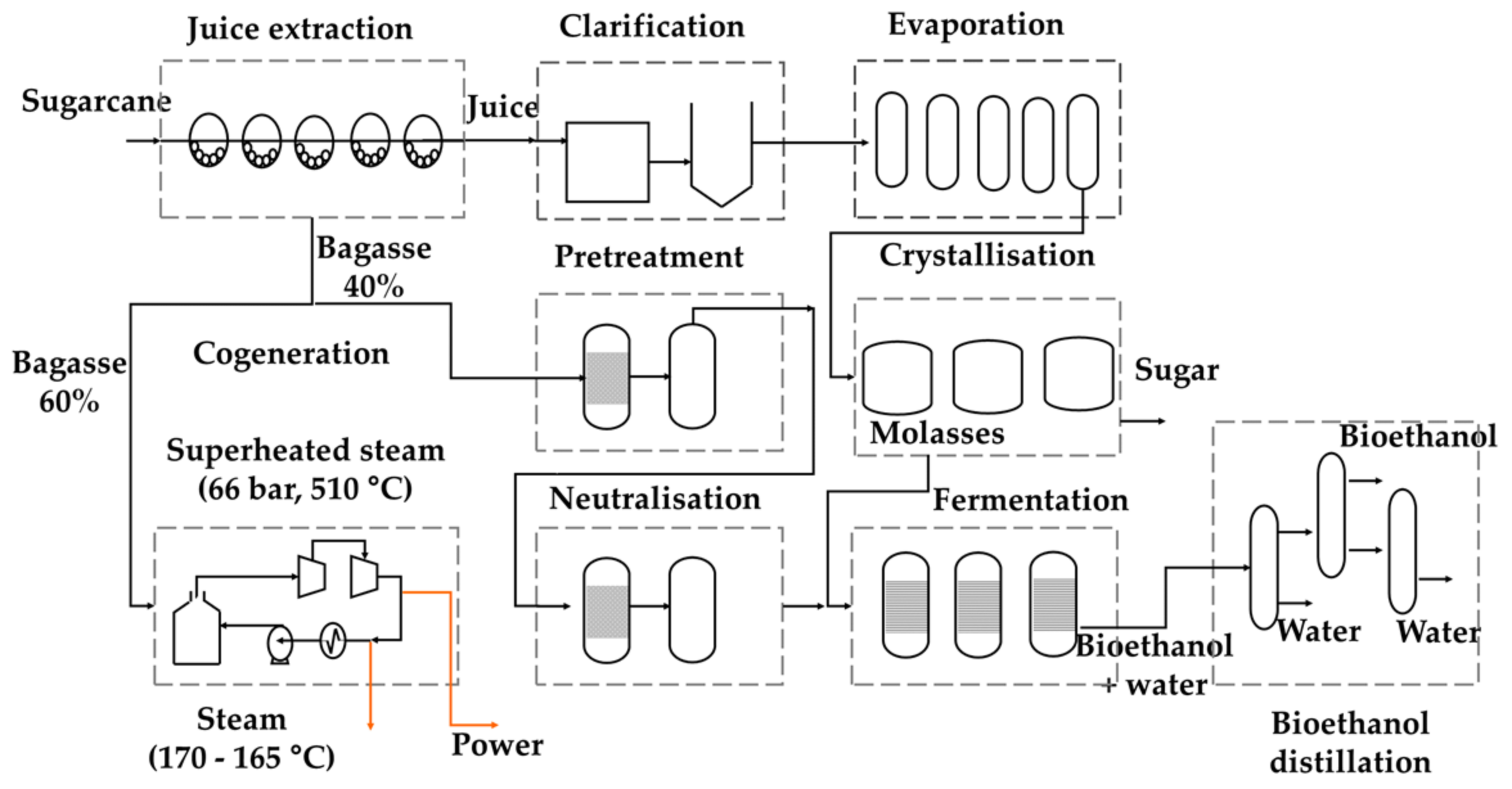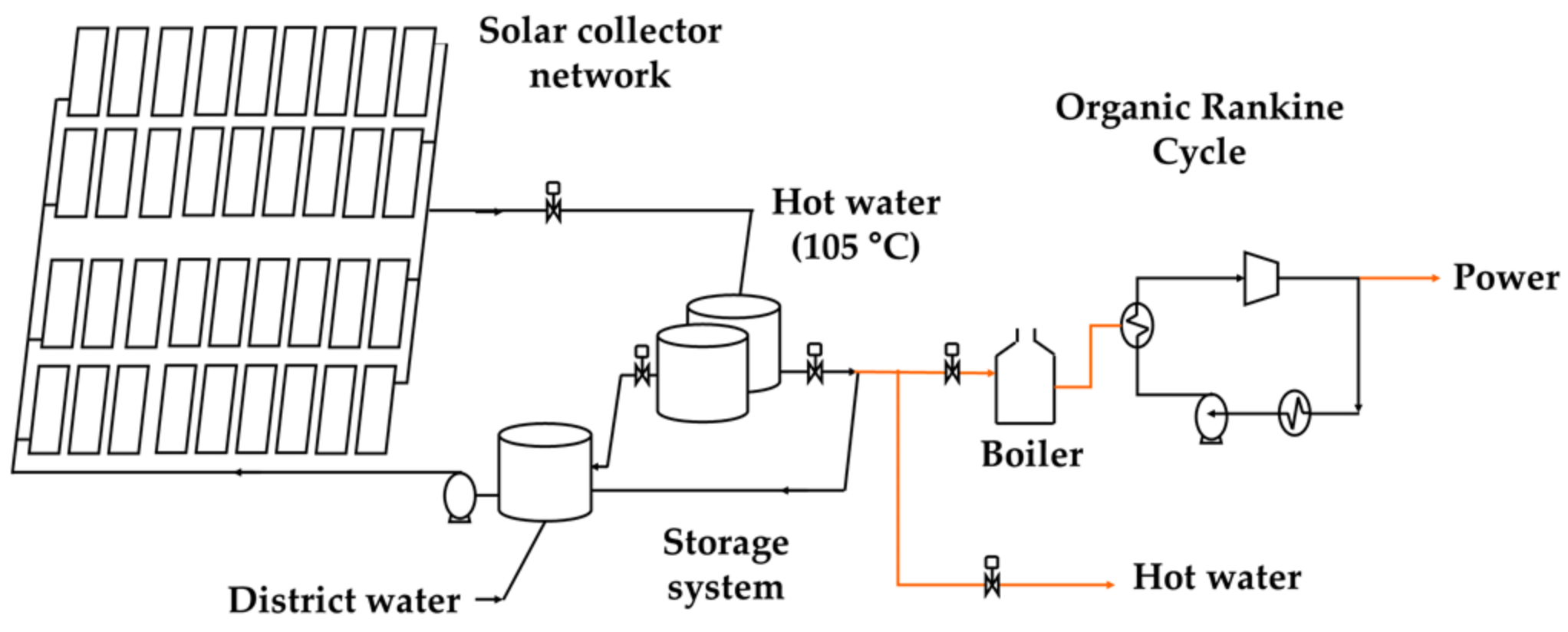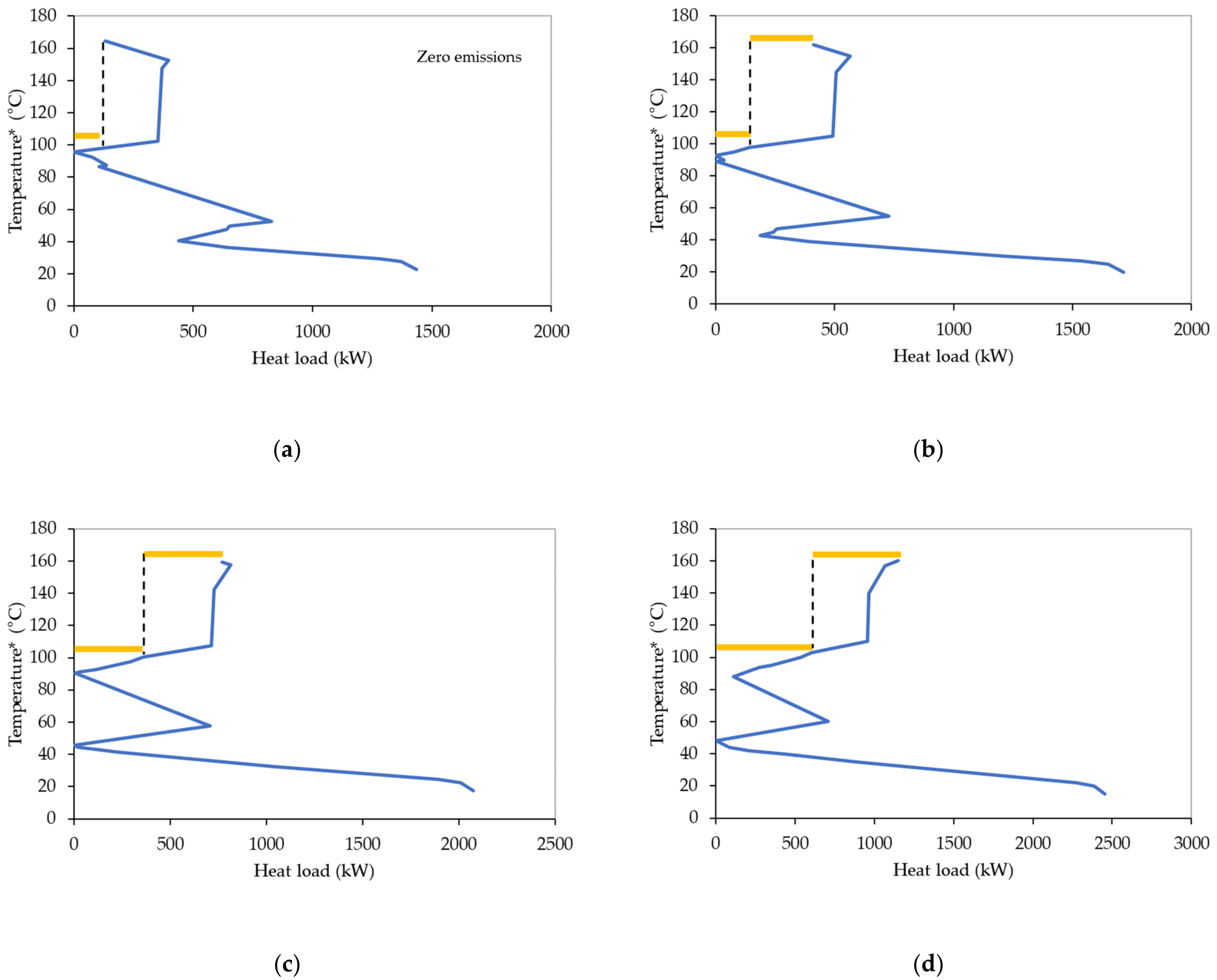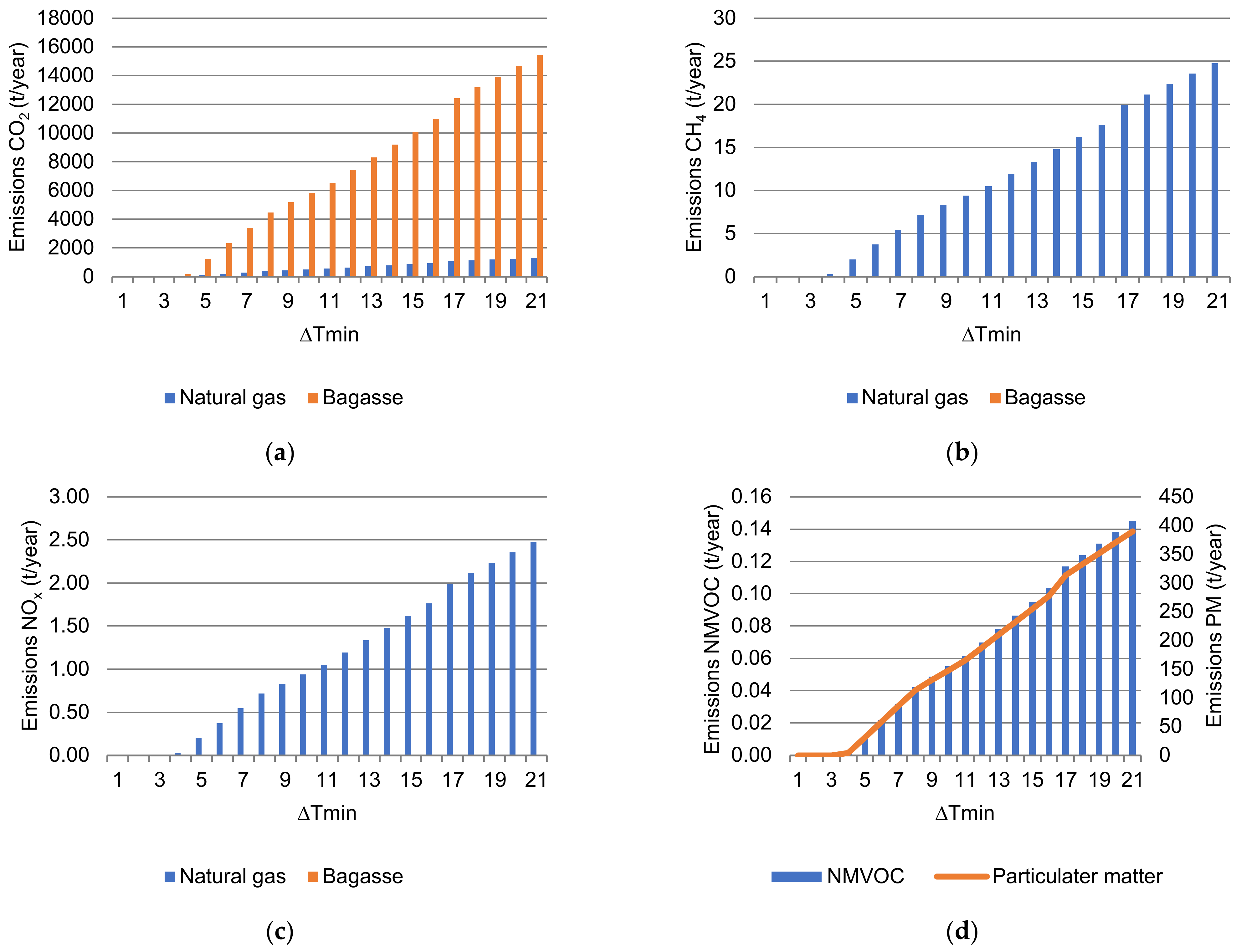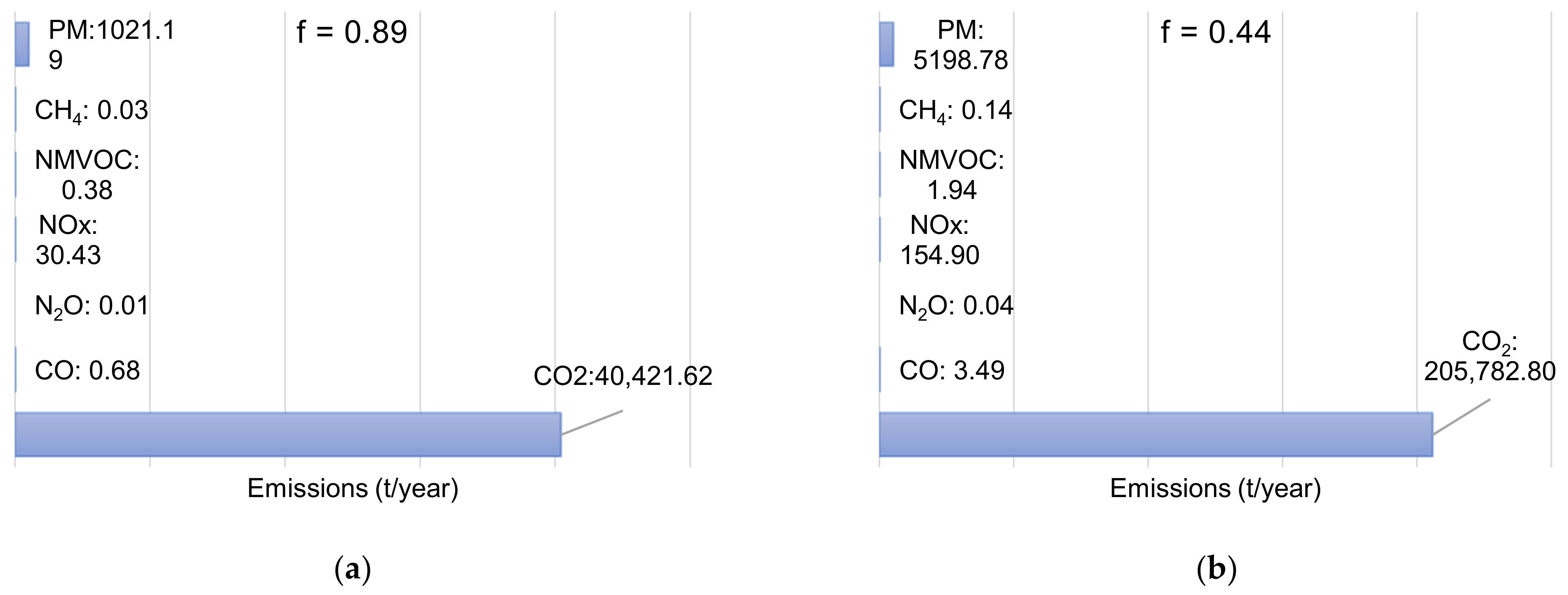1. Introduction
Transition towards renewable energies is a global topic in constant evolution with objectives established a priori. In general, the renewable kWh cost is the parameter that defines the installation of clean technology. There are other parameters that must be considered, including simple payback time, levelised cost and occupied area of the renewable device. All of these are of relevance during design, installation, and operation of renewable systems.
There are some papers related to renewable energy integration in industrial processes. Martínez-Rodríguez et al., in 2019, [
1] carried out the solar thermal energy integration to dairy process, supplying the total heat load. Simple payback times less than three years were calculated. Valderrama et al. (2020) [
2] used 60% of sugarcane bagasse to produce heat and power in a bioethanol production process (1G and 2G). Taking account of the variability of some renewable energies like solar, renewable hybrid systems have been proposed that seek to give confidence and certainty to the energy systems of the industrial sector. Da Silva et al. (2020) [
3] studied the energetic aspects related with the adoption of a hybrid system compound by a parabolic trough collector solar field (PTC), a biomass burner (biomass:
Eucalyptus grandis wooden briquettes), an intermediate thermal oil circuit, a regenerative organic Rankine cycle (ORC), and an absorption cooling system to deliver the energy demand of a small industrial plant in Brazil. It considered the solar energy like the primary source and the biomass as secondary ones. Tsimpoukis et al., 2021, [
4] analysed, in energetic terms, the concept of a trigeneration system of super-critical
to cover the needs of a cold store in Athens, with simultaneous production of electricity and heating. This system took advantage of captured solar energy by PTC and biomass (dry straw) as a supplemental energy source to increase the temperature of
at high pressure in a turbine that is coupled to a generator. The study analysed different scenarios. Simple payback time was four years for solar collectors, and 13.5 years for the biomass boiler. The financial savings were equivalent to EUR 542,000 and EUR 22,900 for the estimated useful life of the project. In the works mentioned above, biomass had a role as a secondary energy or backup system, to buffer the variability of the solar resource.
There is research about the economic and environmental advantages in using biomass co-fired with coal for the reduction of net emissions of
[
5], because there is a balance between the amount of carbon dioxide absorbed by plants while they are growing, and the amount released during biomass burning; an activity that is carried out at an industrial level in European countries with relative success [
6], since the use of fuels obtained from biomass is considered a sustainable energy source, and they are highly recommended as carbon neutral fuels [
7]. However, the common theme of biomass burning is its significant contribution in relevant pollutants in addition to
, such as
and black carbon, to name a few. So, the use of biomass as a renewable fuel must be approached from a comprehensive point of view when evaluating its impacts on the global environment and climate region [
7].
The burning of some biomass residues also produces toxic compounds, including polychlorinated dibenzo-p-dioxins and dibenzofurans (PCDD/F), which are listed as persistent organic pollutants and have been linked to adverse risks to human health that should not be ignored [
8]. These health risks include chloracne, immunotoxicity, endocrine disruptors, mutagenicity, and carcinogenicity [
9,
10,
11]. In the United States, more than 14% of PCDD/F air emissions are from controlled sources of the combustion of wood used for heat and power generation, which is much higher than waste incineration and coal combustion [
12]. Small-scale industrial combustion was also found to be the main source of PCDD/F emission in Guangzhou, China [
13]. The annual estimate of PCDD/F emitted by biomass combustion in the industrial sector was approximately 208 g of l-EQT (international toxic equivalency factors) in China, which represents 2% of total national emissions, annually [
8].
is a widely cited air pollutant that has important effects on ecosystems, human health, and the climate [
14]. Total emissions originating from all sources, including biomass, reached 105.4 Tg in 2014, with 43% coming from power plants and 35% from industry [
15].
emissions are not negligible, especially in many developing countries and certain developed countries [
16]. In the US, France, Germany, Finland, India and other Asian countries, contributions of
to biomass are increasing [
17].
World sugar production is expected to recover from the current fall and rise by approximately 16%, this projected upturn in the economy of the sugar sector will promote an increase in emissions resulting from the burning of biomass.
According to the Intergovernmental Panel on Climate Change, regarding global warming impacts of 1.5 °C [
18], to accomplish the zero
emissions goal in 2050, an unprecedented energy transition is imperative, in all sectors of society. The goal requires the transition from fossil fuels to clean energies to reduce or eliminate the generation of GHG emissions. The industrial sector, in particular, must decrease their direct
emissions, by 2050, by 6 Gt (66% of current levels), and limit energy use to 200 EJ (40% below current levels) [
5]. There is a well-established industry of burning biomass to produce energy across the world. However, it must be borne in mind that regardless of the type of biomass used, gases and particulate matters are emitted in large, uncontrolled quantities, which maintain high levels of carbon in the environment and persistent pollution.
The purpose of this research work was to supply the energy of an industrial process through an energy system design with controlled emissions, through the incorporation of solar energy and biomass. The emissions caused by use of natural gas are compared against those caused by the burning of sugarcane bagasse, since it is generally perceived that the latter generates fewer emissions, compared to other fossil sources. The results indicate that the burning of sugarcane bagasse generates a greater variety and quantity of emissions than natural gas. There are scenarios in which it is possible to integrate an energy system based on solar thermal energy that meets technical, environmental, and economic criteria, which guarantee the total supply of energy for an industrial process. Alternatively, there are scenarios where it is convenient to combine the use of biomass and solar thermal energy, where the former is used setting a priori control of emissions. When the objective is to reach a solar fraction of 0.5, the area of the solar collector network is reduced by 48%. There is a direct relationship between the solar fraction, the emissions, and the area of the solar field.
4. Results and Discussion
This section presents the selection of the renewable devices according to the objective to be achieved, which meets the heat and power requirements to product 1G and 2G bioethanol and reduce the dangerous emissions of pollutants by the burning of biomass. The renewable energies that are being considered in the study are solar thermal energy and biomass (sugarcane bagasse). The selection of defines the targeting for multiple utilities, the minimum utilities, the heat recovery network, plus the size of the network and the renewable storage system. The selection of depends on the objective being pursued.
To supply the heat and power required by the process, two energy systems that operate independently were designed. In the design of the solar thermal installation to supply the heat load of the process, first the Pinch Analysis was used to reduce the auxiliary services, and simultaneously the network of solar collectors was designed to provide this requirement. Subsequently, an organic Rankine cycle was designed to provide the power of the plant where the thermal load of the evaporator is by means of low temperature solar thermal energy.
4.1. Solar Thermal Energy Integration Using Pinch Analysis
Using the concepts of Pinch Analysis, the integration of solar thermal energy was carried out for different
.
Table 9 shows, for each
, the minimum hot utility requirement
, the minimum cold utility requirement
, the Pinch temperature
, the area of the heat recovery network
, the cost of the heat exchanger network
, the costs of auxiliary services
and the total annualised cost of the heat recovery network
.
It is important to highlight in
Table 9, that there exists three
. where the minimum hot utility is small with respect to the rest of the values. The minimum hot utility is related with the heat recovery network and the auxiliary cost. These parameters are used to calculate kWh
th solar, which has the lesser cost for a
.
To identify the multiple utilities, the grand composite curve (GCC) is used.
Figure 3 presents the GCC for different
; an increase in the hot utility requirement is observed as
increases. To supply this thermal requirement through solar thermal energy, as the hot utility increases, the size of the solar collector network also increases. Low-temperature solar thermal energy is supplied at 105 °C. For
greater than 10 °C, the temperature levels to supply the hot utility are greater than 105 °C (therefore, the solar fraction
), and it is not possible to reach those temperature levels with a network of low temperature collectors; however, with the steam obtained by burning bagasse, a window of possibility is highlighted, which are analysed.
4.2. Solar Thermal Installation Design
The design of the solar collector network is made for a temperature of 105 °C during a period of 3 h (11:15 a.m.–2:15 p.m.), with irradiance levels of the winter season. Solar thermal energy is stored to guarantee the supply of the thermal load and the temperature level required by the process.
Table 10 shows the results obtained by evaluating different
, where
is the heat that can be supplied by a solar collector network at 105 °C for a period of 18 h.
and correspond to the auxiliary heating service and its respective cost. To supply the thermal energy requirement of the process, it is necessary to have a storage system to guarantee the heat load at the target temperature level. The design of the solar collector network was based on values of irradiance data in the winter period in the city of Guanajuato. The dimensions of the components of the solar thermal installation and their costs are also shown, to estimate the total investment .
The
Table 10 shows the
; where the solar fraction is equal to one, it means the emissions to atmosphere are zero. The
equation presents the minimum solar collector network and solar storage thermal cost. However, in the analysis there are other variables that must be considered, like the solar network area, limitations on installation area of the renewable system, and heat recovery network cost for the selection of
. There are many possibilities that could be the object of study that could be reached, using the result presented in
Table 9 and
Table 10.
Table 11 shows the energy savings, the payback of the solar thermal installation and the energy costs in USD per kWh for each
, which could be reached depending on the objective sought. The levelised cost of solar thermal energy
corresponds to the solar thermal system, while the integrated system cost
includes the solar thermal system, storage system and the heat recovery network system.
The
does not present significant variations for different
, in contrast to the
, due to the cost of the heat recovery network
.
Figure 4 shows the results of the emissions generated by using natural gas and bagasse as fuel to produce the heat required by the process.
Emissions for different
are estimated for the combustion of natural gas and bagasse. For a
between 5–7 °C there are zero emissions, but the
is higher. Analysing the
Figure 4a, it could be observed that
emissions are much higher for bagasse compared to natural gas; for bagasse it represents 97% of total emissions. In
Figure 4b,c, natural gas emits higher amounts of
and
into the atmosphere compared to bagasse.
Figure 4d shows the emissions of NMVOC and PM for bagasse burning, and it is clearly observed that a large amount of solid particles are released into the environment. In all the graphs it is observed that at higher
the emissions grow; this due to the influence of the heat recovery network. For
between 5 and 7 °C, it is feasible to completely replace the use of fossil fuels for heat supply. When there are higher
, the auxiliary services increase, as do the emissions: this at a lower levelised energy cost of the integral system,
.
4.3. Organic Rankine Cycle Results
The working fluid selected to be used in the power cycle to supply electrical energy to the process was the R290, due its thermodynamic properties and impact on the environment, (ODP = 0) and (GWP = 3). It is considered that to generate a power of 3.15 GW for 18 h, it is necessary to assume a total thermal load on the evaporator, and this is supplied by a solar thermal system (solar collector network and storage system) at 105 °C. The temperature in the evaporator is 90 °C for the design of the cycle and its components, and the condenser is considered to operate at atmospheric pressure. The design conditions of the ORC are shown in
Table 12.
The results for different solar fractions are presented in
Table 13. By varying the solar fraction
(f), one part of total power will be supplied by the solar resource, and the other with the burning of biomass. The results show a lineal relationship that exists between the solar fraction with the size and cost of the components of the solar thermal system. However, the installation area of thermal storage
, compared to the surface required by the solar collector network
, is 116 times smaller. With the use of biomass, it is possible to reduce the cost, the number of collectors, and the installation area.
Table 14 presents the levelised cost of energy of the ORC for different solar fractions, and also estimates the total cost of the annualised solar thermal installation. There are many important results that must be highlighted: simple payback time is almost the same for the solar fractions; savings for any solar fraction are big; cost associated with burning biomass increases significantly when the solar fraction decreases; and the cost of electrical power using solar thermal energy and biomass
is lower as the solar fraction increases.
Emissions from burning sugarcane bagasse, for the power cycle, are shown in
Figure 5 for two different solar fractions. For an
f = 0.89, the amount of
emissions (40,421.62 t/year) and PM (1021.19 t/year) represents a serious impact on the environment and health due to the tons and the danger of the substances emitted.
4.4. Ways to Use Biomass and Solar Thermal Energy (Two Renewable Energies)
Case 1: Zero emissions. When the objective of the design is to completely replace the use of biomass, reducing to zero the emissions to supply the total heat and power to the process, the selected is 7 °C, which has the lowest levelized cost of energy, 0.0636 USD/kWh. The required area of the solar collector field is 2813 m2. The levelised energy cost for power production is 0.1392 USD/kWh, and the simple payback of the Rankine cycle is 20.9 years.
Case 2: Reduce NMVOC and PM emissions according to environmental regulations, or else, to minimize the impact on health. If the goal is to eliminate 10%, 30% or 50% of these emissions, the cost of electricity () and the simple payback are maintained, at an average of 0.1394 USD/kWh and 20.8 years, correspondingly. With this objective, 1.73 t/year of NMVOC and 4642 t/year of PM are no longer released into the atmosphere. The levelised cost of electrical energy is 0.1394 USD/kWh for a solar fraction f = 0.50. Solar collector area was reduced by 48% with respect to the area for a solar fraction of one, with a simple payback time of 20.8 years.
Case 3: Reduce the size of the network collectors and storage system for power production. In this case, the design objective focuses on the availability of plant area for solar thermal installation. The solar collector field represents the largest required area of space compared to the storage surface, at a ratio of 116 times. If there is an available area of 10 hectares of surface, the solar fraction suggested to supply the power required by the process would be 0.22, with a total emission, , of 294,091 t/year.
For the three cases, the heat process is supplied completely with solar thermal energy with a of 7 °C.
The use of the renewable system, composed by solar thermal energy and biomass, is based on the preferential use of solar thermal energy, controlling the characteristic emissions originated by bagasse burning.
In the present work, three scenarios were studied; however, several more can be considered where a different objective set could be addressed, such as the limitations of installation area, project investment and payback time, and solar collector network area, among others.
The results achieved show that the relationship between the variables , heat recovery network, solar collector network, storage tank, installation area, , , emissions, project investment and payback time defines the final design of the renewable energy system composed by solar thermal energy and biomass.
It is sought that the reduces the auxiliary heating service, and thus eliminates the largest amount of emissions considering the profitability of the system. It is noted that the cost of solar thermal energy () is in a range of 0.0649–0.0621 USD/kWh; however, when adding the cost of the heat recovery network, this value is increased by 0.7363–0.4926 USD/kWh, that is, the cost of the integrated system is doubled due to cost to the heat recovery network. In power production, the average levelised cost of energy () is 0.1394 USD/kWh, which remains practically constant when the solar fraction varies. However, the solar collectors network area for power production changes drastically with the solar fraction. In the same way, when solar fraction decreases, with a consequent rise in biomass burning, the tons are 12 times the amount generated by the burning of natural gas. Reduction of emissions should be a design target in itself.
In the study by Tilahun et al., 2020, [
33] regarding the cogeneration of heat and electricity, they proposed a hybrid solar-biomass energy system. They performed an optimisation with the objective of maximising the solar fraction with the lowest investment cost, obtaining
= 0.094 USD/kWh for
f = 0.235. A
Prosopis juliflora tree was used as biomass, because it is abundant in the study location. However, the burning of wood did not solve the long-term environmental impact. In the present work, with a
= 0.1392 USD/kWh (
f = 1), it is feasible to eliminate the emissions.
5. Conclusions
The proposed approach enabled control of the generated emissions, putting special attention on the dangerous emissions produced by the burning of biomass. It is not possible to use biomass burning as a backup system, but rather as a complement where the operator has control over the amount of emissions generated and the consequent impact on the environment.
Based on the results in one of the analysed cases, it is feasible to supply the full thermal load of the process, thus eliminating the burning of bagasse and the generation of dangerous emissions to atmosphere.
In power production, the area of the solar collector network can be reduced by 68% by decreasing the burning of bagasse by 30%, keeping the energy cost and recovery time constant (0.1395 USD/kWh, 20.8 years).
Regarding power production, there is an area of opportunity, because the technology efficiency must be improved to reduce the large areas of solar collectors (32 hectares) that are required. This makes evident the convenience of using biomass, as long as it is controlling emissions.
The design method can be adjusted for other renewable technologies and globally to assess the environmental impact and economic cost. Regarding the existing control from the design, and the generation of emissions into the atmosphere, it can be adjusted according to the regulations of each country or region.
In any of the scenarios proposed, the cost of electrical energy and thermal energy is competitive compared to the global market.
